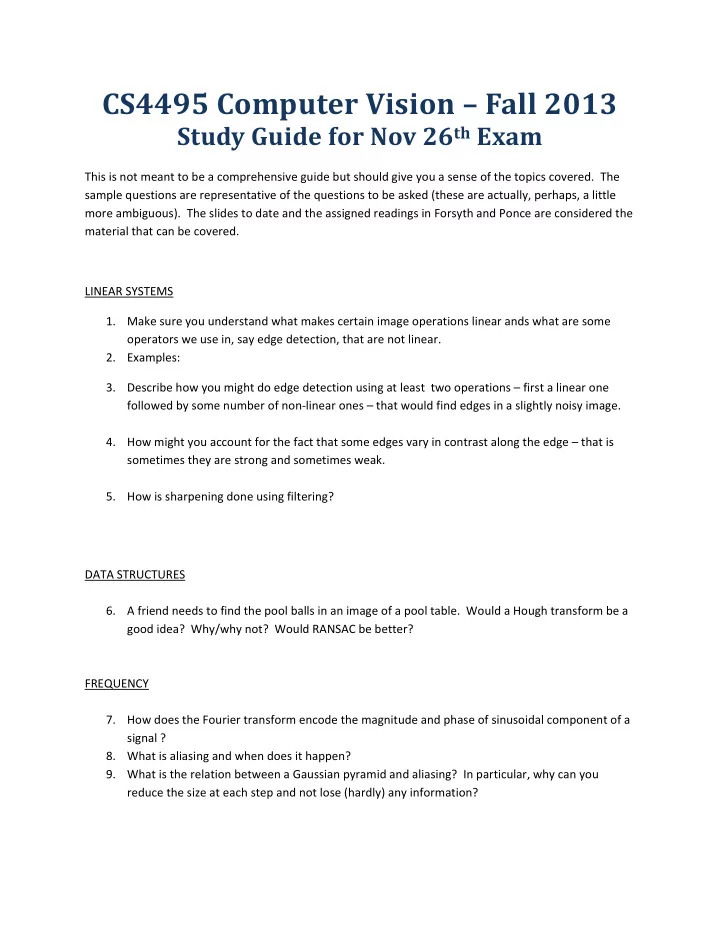

CS4495 Computer Vision – Fall 2013 Study Guide for Nov 26 th Exam This is not meant to be a comprehensive guide but should give you a sense of the topics covered. The sample questions are representative of the questions to be asked (these are actually, perhaps, a little more ambiguous). The slides to date and the assigned readings in Forsyth and Ponce are considered the material that can be covered. LINEAR SYSTEMS 1. Make sure you understand what makes certain image operations linear ands what are some operators we use in, say edge detection, that are not linear. 2. Examples: 3. Describe how you might do edge detection using at least two operations – first a linear one followed by some number of non-linear ones – that would find edges in a slightly noisy image. 4. How might you account for the fact that some edges vary in contrast along the edge – that is sometimes they are strong and sometimes weak. 5. How is sharpening done using filtering? DATA STRUCTURES 6. A friend needs to find the pool balls in an image of a pool table. Would a Hough transform be a good idea? Why/why not? Would RANSAC be better? FREQUENCY 7. How does the Fourier transform encode the magnitude and phase of sinusoidal component of a signal ? 8. What is aliasing and when does it happen? 9. What is the relation between a Gaussian pyramid and aliasing? In particular, why can you reduce the size at each step and not lose (hardly) any information?
CAMERA MODELS 10. What is the role of an “aperture” in a typical camera? Why would you want a large aperture? Why would you want a small one? 11. How many degrees of freedom are in extrinsics and intrinsics? What are they? 12. How many 3D points need to be observed to do absolute calibration? Why? 13. Write the perspective projection equation as a 3x1 = [3x4] * [4x1] STEREO 14. Given two cameras and a point P in the world, draw out the epipolar plane geometry. 15. What is the difference between the essential matrix and the fundamental matrix? 16. We view some world point P with two parallel cameras separated by baseline B meters, and with a focal length of f. If the world point P is located horizontally at x L in the left image (in the same units as f ) and x R in the right image the disparity d is (x L -x R ). Write the formula for the depth Z of P in terms of d, B, and f 17. What are some constraints about the viewed surface or that matching that reduce the search in looking for stereo matches? SHADING 18. What is Lambertian shading? 19. If a surface is Lambertian, how many known light sources would you need to turn on (one at a time) to figure out the orientation? FEATURES 20. We say that point descriptors should be both “invariant” and “distinctinve”? What do we mean by “invariant” and why is it good? 21. How can we make a feature detector (like SIFT) invariant to illumination? Rotation? 22. Harris corners are found by looking at a 2 nd moment matrix. Why? MODEL FITTING 23. Suppose we are using RANSAC to find circles. Our inputs might be points or points with oriented edge elements. What would the argument be as to why using only points is better? What would the argument be as to why the oriented edge elements would be better? 24. The ICP (iterative closest point) algorithm tries to align two structures that can be in any dimension but usually 2 or 3. The algorithm requires knowing which points on the two structures correspond. What does it assume to find corresponding points?
MOTION 25. What is the Brightness constancy constraint equation and what are the unknowns? 26. Lucas and Kanade is the optic flow method based upon gradients. What are the assumptions of the method? ACTIVITY 27. How are HMMs used in activity recognition? 28. What are the three fundamental problems to be solved when using an HMM? And what is the forward algorithm? TRACKING 29. Tracking is iterating between Prediction and Correction. In terms of the observations, prediction can be written as: ( ) = = = P X Y y Y , y , , Y y − − t 0 0 1 1 t 1 t 1 Write out a similar expression for the correction step. 30. There are two independence (or conditional independence) assumptions in the tracking we did (Kalman or Particle). What are they? Hint – one has to do with the states, the other with the obervations. 31. The Kalman filter assumes Gaussian distributions about the prediction and two other model elements. What are those elements? ( X , X ,..., X ) 32. Assume you have K points in an N dimensional space where N>>K. You want 1 2 K k ∑ T ( X X ) to compute the eigenvectors of . At most, how many eigenvectors are there? i i = i 1 (Think about 3 or fewer points in 3D space if that helps.)
Recommend
More recommend